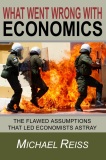Saturday, 11 February 2012
The money paradox
On one side we have: “Banks can create money out of nothing. They do not need to have somebody’s savings in hand in order to make a loan”.
On the other side we have: “Banking regulations dictate that banks are only allowed to lend out a fraction of their depositors money”.
These arguments appear irreconcilable. So who is right? And how could there have been any doubt?
The reason the argument rages so often is that they are both right. The reason for this is quite subtle and not discussed at all in standard economics textbooks.
People will point out that banks can only lend out a fraction (albeit a large fraction) of money they are looking after from their depositors. And they may have to pay interest to those depositors whose money they are lending. This way banks are seen as making money from the difference between the interest they pay to whoever they got the money from and the interest they charge to whoever they lend the money to.
They point out that banks are not allowed to lend out money they don't have.
This is where we have to examine things a bit more carefully. We need to consider how this is enforced: Let us consider those people at the bank who's job it is to make loans. Do you imagine that they have a hotline to some other person in bank that monitors how much money the bank has on deposit on a second by second basis? Can you imagine a situation where you go into a bank, discuss a loan and then the banker says “hang on, I have just heard that we used up all our funds twenty seconds ago, can you come back tomorrow?” Of course not, the system is managed on a much more approximate basis where the loans made and the deposits taken (or money borrowed from other banks) are monitored over some period of weeks. The regulations are only concerned with these long-term averages.
But this attention to averages opens up an opportunity for a leak in the system: what can now happen is that banks can lend out money they don't currently have and then in order to comply with regulations they can borrow the money from other banks at a later time. You may note however that the (created out of nothing) money lent out will end up being in another bank somewhere. Thus money can then be borrowed back by the bank that made the loan in the first place. This means that no previously existing money was required. The bank has created money out of nothing and borrowed it from a depositor!
To summarise: It is true that banks make money from the difference between what they have to pay in interest from wherever they get their money from and what they receive in interest from whoever they land money to - but because the order of events (borrow-then-lend vs. lend-then-borrow) can occur either way round, it is also true that banks can create money out of nothing.
The number of economists that are aware of this subtle phenomenon is tiny.
Tweet
Tuesday, 7 February 2012
Is interest repayable?
This view is however, mistaken. The key thing to note is that the interest paid does not simply accumulate at the bank. Nobody runs a business in order to just make a big pile of money to keep in a safe. The banks spend the money back into the economy through staff wages, running costs and dividend payments to shareholders. All these outflows of money will ultimately be spent on real goods and services produced by the rest of the economy. This flow of money is a source of money for the interest payments.
You can get an idea of what is going on by imagining an economy with a fixed money supply. The figure below shows a hypothetical flow of the money in the economy. The flow marked "trade" and is simply the money circulating back an forth between households and industry as people earn money and spend it on what has been produced in the factories.
In a steady state, the rate of flow of money being created as new loans (shown as "loans" in the diagram) will be equal to the rate of flow of money being paid back in principal repayments (i.e. before interest payments).
At the same time the loan interest payments are equal to the spending by banks (those staff wages, running costs and dividend payments to shareholders).
As you can see, the flows can balance. Nothing is broken, no new money needs to be added to pay the interest. The system can continue indefinitely.
A more realistic model of our monetary system has been simulated on computer by Professor Steve Keen of the University of Western Sydney. His simulations also show that there is no problem repaying interest, even if the money supply is constant.
The fact that there is no in-built mathematical paradox to avoid when paying back interest does not necessarily guarantee that all loans will be paid back; far from it. If someone borrows a large a sum on the basis that they expect healthy future income to repay the interest there is always scope for things to go wrong. They may lose their job, or they may become ill; perhaps their business plan was flawed and the product they are making proves unpopular. Any of these problems may lead to a situation where the loan repayments are larger than the borrower can ever reasonably pay back. This is possible even if the loan was interest free.
In conclusion we can now see that it is not essential for the money supply to grow in order for interest payments to be made on loans without defaults. There many problems caused by fractional reserve banking, some of them severe, but inherently unpayable interest is not one of them.




